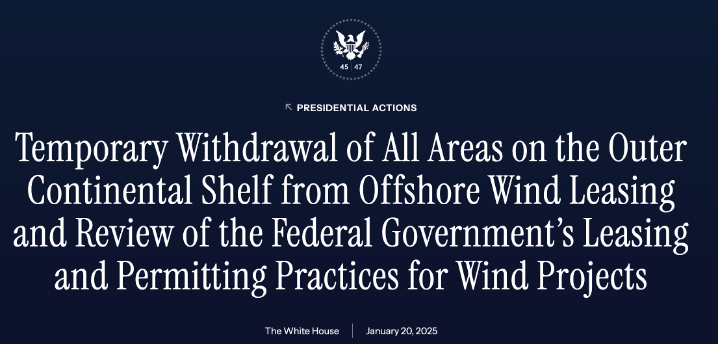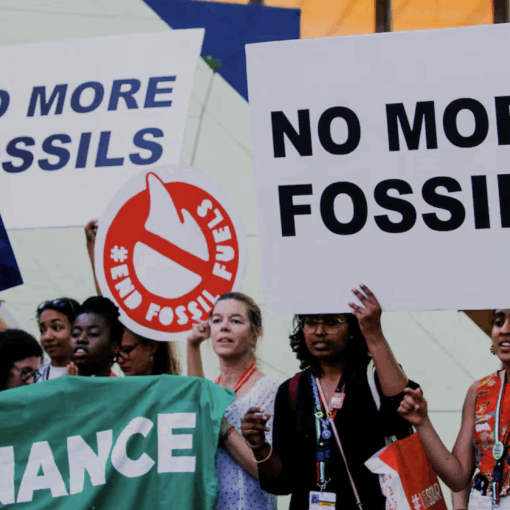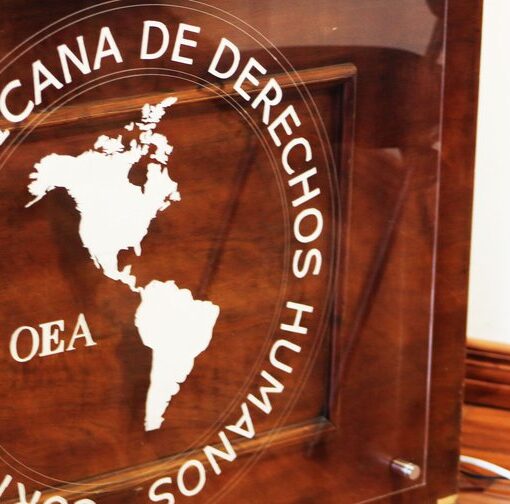This post is part of a new Climate Law Blog series, 100 Days of Trump 2.0, in which the Sabin Center offers reflections on the first hundred days of President Trump’s second term across a variety of climate-related topics. To read other posts from the series, click here.
President Trump retook the White House in the midst of a booming transition from fossil fuels to clean energy. In the first 100 days, the second Trump Administration has taken drastic measures to curb the momentum of that transition. This blog post will focus on the ways in which the Trump Administration has attempted to impede the siting and permitting of renewable energy facilities—particularly offshore and onshore wind—while, as other posts on this blog have addressed, simultaneously seeking to expedite the siting and permitting of fossil fuel facilities.
Background: Current Status of the Energy Transition
Before we look at what the Trump Administration has done to obstruct the deployment of wind (and, to a lesser extent, solar) energy facilities, it is important to understand how much momentum the energy transition has recently picked up in the United States. In 2024, approximately 93% of new capacity that came online nationwide was wind, solar, and battery storage. For the first time ever, the United States received more electricity in an 11-month period from wind and solar than from coal. While fossil fuels still generated approximately 58% of electricity nationwide, wind and solar generated at least 33% of electricity in ten states. Importantly, while tax credits have helped to speed up the energy transition, studies show that wind and solar are now among the cheapest forms of energy, even when subsidies are excluded. In short, under present market conditions, renewables are poised for continued growth.
Trump 2.0’s Full Frontal Assault on Offshore and Onshore Wind—and Collateral Damage to Other Renewables
On the campaign trail last year, Trump promised to “make sure that [offshore wind] ends on day one,” specifying that he would “write it out in an executive order.” At the time, it was not clear exactly what the candidate’s plans for “ending” offshore wind would entail—or how far he intended to go. Would he attempt to stop new lease sales, but leave the eight fully permitted projects currently in development alone?
So far, the second Trump Administration has opted for the most extreme approach. As discussed below, the Administration has moved to end all new leasing for offshore wind; freeze all federal permitting for offshore and onshore wind; and block construction of fully permitted projects, both by rescinding permits and by issuing stop-work orders. At least two federal agencies, the Interior Department and the Army Corps of Engineers, temporarily froze (but later resumed) permitting for solar, too. This section will look at some of the key developments.
1. The January 20 memorandum
The President’s assault on wind energy began, as promised, on day one. Specifically, on January 20, 2025, Trump issued a presidential memorandum titled Temporary Withdrawal of All Areas on the Outer Continental Shelf from Offshore Wind Leasing and Review of the Federal Government’s Leasing and Permitting Practices for Wind Projects. While the title of the memorandum was lengthy, it nonetheless failed to adequately capture the memorandum’s breathtaking scope. The memorandum set out four lines of attack on wind energy projects:
- Temporarily withdrawing “all areas” within the outer-continental shelf from new leasing for offshore wind, thereby blocking any new lease sales for offshore wind projects;
- Temporarily freezing all federal permitting for onshore and offshore wind, pending a “comprehensive assessment” of the “potential inadequacies in various environmental reviews” and of impacts on “navigational safety interests, transportation interests, national security interests, commercial interests, and marine mammals”;
- Temporarily imposing a moratorium on the construction and development of the fully-permitted Lava Ridge Wind Project on federal land in Idaho; and
- Encouraging the Attorney General to “provide notice” of the January 20 memorandum to any court where litigation over federal permits for wind projects is pending and to “request that the court stay or otherwise delay further litigation.”
Importantly, while the first three items in the list are described as “temporary” measures, the memorandum did not specify an end date. In addition, the fourth and final item on the list seems to invite the U.S. Department of Justice to stop defending the federal governments’ own permits for wind projects when those permits are challenged in court. This could be a real issue, as permits for several offshore wind projects, including South Fork Wind, Revolution Wind, Coastal Virginia Offshore Wind, and Vineyard Wind, have been challenged in court.

The memorandum is highly vulnerable to legal challenge, including on the basis that the permitting freeze and other actions are beyond the authority of the president, or “ultra vires.” For example, there is no law that gives the president the authority to cease all permitting of wind projects or to issue a stop-work order on a fully permitted project. In addition, there is recent precedent rejecting similar efforts to pause leasing (for oil and gas development) by the Biden Administration. Finally, while the memorandum suggested that environmental review for wind projects has been inadequate, that claim is completely baseless, as are the memorandum’s vague insinuations about impacts to marine mammals. Indeed, a recent analysis by the Government Accountability Office (GAO) found that NOAA Fisheries “does not anticipate any death or serious injury to whales from offshore wind related actions and has not recorded marine mammal deaths from offshore wind activities.”
2. Actions by federal agencies to halt the issuance of new permits
Federal agencies quickly fell in line with the President’s directive that they “shall not issue new or renewed approvals, rights of way, permits, leases, or loans for onshore or offshore wind projects.” In a few instances, federal agencies even went beyond the presidential memorandum by targeting other renewables, too. Two noteworthy actions by federal agencies include:
- Interior Department. On January 20, the Interior Department imposed a 60-day pause on permitting for all “onshore or offshore renewable energy” projects, including solar energy. Following the expiration of the pause on March 21, the Interior Department’s Bureau of Land Management (BLM) reportedly resumed permitting for solar, storage, and geothermal projects—but not for wind.
- Army Corps of Engineers. On February 5, the Army Corps of Engineers temporarily paused permitting for wetland impacts for 168 renewable energy projects. While the Army Corps announced on February 6 that it was lifting the pause, it clarified on February 12 that the pause was still in place for on-shore wind
These and other agency actions may be vulnerable to challenge under the federal Administrative Procedure Act (APA). The APA allows a court to vacate and set aside any agency action that is “arbitrary, capricious, an abuse of discretion, or otherwise not in accordance with law.” The agencies have provided almost zero reasoning to support their permitting freezes, no evidence, no opportunity for notice-and-comment, and no consideration for the rights of parties that have already executed leases with the federal government.
Importantly, only about 4% of renewable energy projects are currently on federal land, so a BLM pause would only affect a subset of projects. However, the total capacity in the BLM pipeline is still quite large: at the time President Trump took office, there were approximately 30 GW of projects in the permitting pipeline that had not yet been approved, including 25 GW of solar, 2.8 GW of wind, 1.5 GW of gen-tie, and 0.2 GW of geothermal. Moreover, projects on private lands frequently require approvals from the Army Corps of Engineers and other agencies, such as U.S. Fish and Wildlife.
On a related note, one bright spot for renewable energy development is that the Federal Aviation Administration (FAA) has continued to issue determinations of hazard (or no hazard) to aviation, which are required for most structures over 200 feet tall, including wind turbines. When the January 20 memorandum freezing federal approvals was released, there was a concern that the FAA would cease issuing these determinations. However, the FAA apparently concluded that these determinations are not “approvals” and that they are therefore outside the scope of the January 20 memorandum.
3. Actions by federal agencies to block the construction of fully permitted projects
While the January 20 memorandum only attempted to block one fully permitted project—the onshore Lava Ridge Wind project—federal agencies have subsequently attempted to block two fully-permitted offshore wind projects:
- Atlantic Shores. On March 14, the U.S. Environmental Protection Agency (EPA) withdrew the air pollution permit it had issued for the 2.6-GW Atlantic Shores Offshore Wind Project, which is set to be built off the coast of New Jersey. The agency announced that it was voluntarily remanding the permit in order to reevaluate the Project and its environmental impacts in light of the January 20 memorandum.
- Empire Wind. On April 16, the Interior Secretary directed the Bureau of Ocean Energy Management (BOEM) to impose a stop-work order on the 810-MW Empire Wind 1 Project. In that letter, Secretary Burgum argued, without presenting any evidence, that “the project was rushed through by the prior Administration without sufficient analysis or consultation among the relevant agencies as relates to the potential effects from the project.”
These decisions to rescind permits and issue stop-work orders on fully permitted projects are textbook examples of arbitrary and capricious agency actions, and they are vulnerable to challenge. Moreover, they are baffling on their own terms. With respect to Atlantic Shores, the permit that EPA withdrew would have allowed modest emissions during construction; those emissions are miniscule in comparison to the emissions avoided by shifting from fossil fuels to wind.
With respect to Empire Wind, the notion that the approval process or environmental review was rushed is also untenable. As my colleagues have written on this blog, the Trump Administration is currently trying to limit environmental review for fossil fuel projects to 28 days to address a purported energy “emergency.” Empire Wind, for its part, has been in planning and development since 2011; it has held an executed lease since 2017; and it has undergone multiple rounds of environmental review, including most recently a 2.5-year review of the construction and operations plan. If the Trump Administration is going to argue that environmental review for fossil fuels must be limited to 28 days, it cannot in good faith argue that 2.5 years was not long enough to study the construction and operations plan of this project. The developer has reported that it is considering its legal options. Many other Trump Administration actions would appear to be equally vulnerable to challenge.
Update: On May 5, within hours of this post, a coalition of 18 state attorneys general filed a lawsuit to challenge the January 20 memorandum and to enjoin federal agencies from implementing it.
Matthew Eisenson is a Senior Fellow at the Sabin Center for Climate Change Law, where he leads the Renewable Energy Legal Defense Initiative (RELDI).





